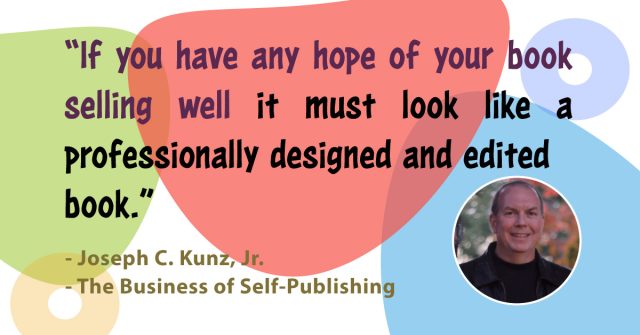Podcast: Play in new window | Download
Subscribe: Apple Podcasts | Spotify | Pandora | RSS | More
Updated September 24, 2023
Subtitle
Avoiding book formatting and design blunders can dramatically enhance your sales
Synopsis
If your hope is that your book gets noticed and bought, then it must look and read like a professionally designed and edited book. These desirable qualities immediately show your audience you have respect for yourself, your readers, and your subject matter. This mutual trust will help you build a dedicated audience that will take you and your advice seriously and continue to buy and read your publications.

What You Will Learn
1. You will learn non-fiction authors’ most common mistakes when creating their books.
2. You will learn to recognize these mistakes and how to fix them.
3. You will learn how and why avoiding these mistakes in the first place will help you sell more books.
Introduction
If your hope is that your book gets noticed and bought, then it must look and read like a professionally designed and edited book. These desirable qualities immediately show your audience you have respect for yourself, your readers, and your subject matter.
This mutual trust will help you build a dedicated audience that will take you and your advice seriously and continue to buy and read your publications.
These attributes might sound obvious at first glance, but it takes a lot of work and planning to make it all come together correctly. And unfortunately, your book might never find an audience if they find it lacking.

Why I Made This List
So, with all that said, if you want your non-fiction book to get noticed, purchased, and impress your clients, then you need to avoid these common mistakes and pitfalls listed here. I developed this list from my own reading experiences.
I have read thousands of non-fiction books and noticed that these mistakes are not limited to small publishers and new authors. I see some of these same problems in the publications of some of the largest publishers.
Just A Simple Reminder
And please, never forget that as a self-publisher, YOU are solely responsible for your book’s success and reputation, so you must be attentive to avoiding these missteps. Even if you have hired a designer, editor, proofreader, etc., the finished product is your responsibility.
10 Common Mistakes to Avoid When Self-Publishing Your Non-fiction Book
Mistake # 1: Missing Sections
Include all of the standard sections of a book. This means the title page, copyright page, table of contents, etc. Readers expect your book to look like an actual, professionally edited, and designed book.
Mistake # 2: Cramming It In
Use proper margins. Making your margins too small will make reading your book difficult and unpleasant. The top, bottom, inside, and outside margins are each different, and each needs to be the appropriate size. And always use an easy-to-read font for your text.
Mistake # 3: Bad Cover
Change your cover if it is not working. We all know about first impressions and how they will affect your sales and reputation. Do not hesitate to hire a professional cover designer for a few hundred dollars.
Mistake # 4: Not Enough Proofreading
Find every typo and grammatical error in the book. Do not be afraid to hire a professional proofreader. A professional can find mistakes that you have overlooked a hundred times. Use grammar software on your text before sending it to a professional.
Mistake # 5: Missing ISBN
Include an ISBN and barcode on the back cover. Include the ISBN on your copyright page. No retailer will sell your book without it.
Mistake # 6: Improper Structure
Your writing and content must have the proper structure. Every chapter and every paragraph must have a beginning, middle, and end. Your book must progress in such a way that the reader can easily follow along. If it doesn’t, the reader will get confused and quickly tire of reading your book.
Mistake # 7: Not Providing Solutions
Never forget that your reader is reading your book because they want to find a way to solve their problems. You can explain how you overcame your problems or made your business a success. But the reader is most interested in how your concerns and solutions can help them. Always keeping the reader in mind will make your book a financial and critical success.
Mistake # 8: Making It Too Long
Keep your non-fiction book shorter. If it is too long, the reader will become overwhelmed and lose interest in your book. Readers are hurrying to apply your lessons and solutions to their problems. Get right to the point.
Mistake # 9: Not Writing from Your Heart
Do not create a generic book with content written hundreds of times before. Ensure your content is written directly from your heart – from your experiences and viewpoint.
Do not sugar-coat or spin the mistakes and problems you had to deal with. Honesty, sincerity, and sharing will make your book different from all the others that came before yours. Readers will appreciate and respect this frankness. And this is the best way to connect emotionally with the readers.
Mistake # 10: Forgetting About The Reader
Ensure your content inspires and motivates your readers to improve their lives. Your mindset should be that you are writing your book to help your readers, not to make yourself a lot of money.
If you produce a book that truly and honestly wants to help readers improve their lives, you and your book will be respected and read. The reader’s needs must come before your needs. If the readers sense any dishonesty on your part, they will not read your book. And they won’t buy your next book.

Conclusion
By creating a well-produced, well-crafted, and professional-looking book, you will immediately show your audience that you respect yourself, your readers, and your subject matter. These attributes will also help you build a dedicated audience that will take you and your advice seriously and continue to buy and read your publications.
Questions to Think About
11. What big mistakes did you make when creating your book?
2. Did you recognize these mistakes before or after publishing your book? What did you do then?

